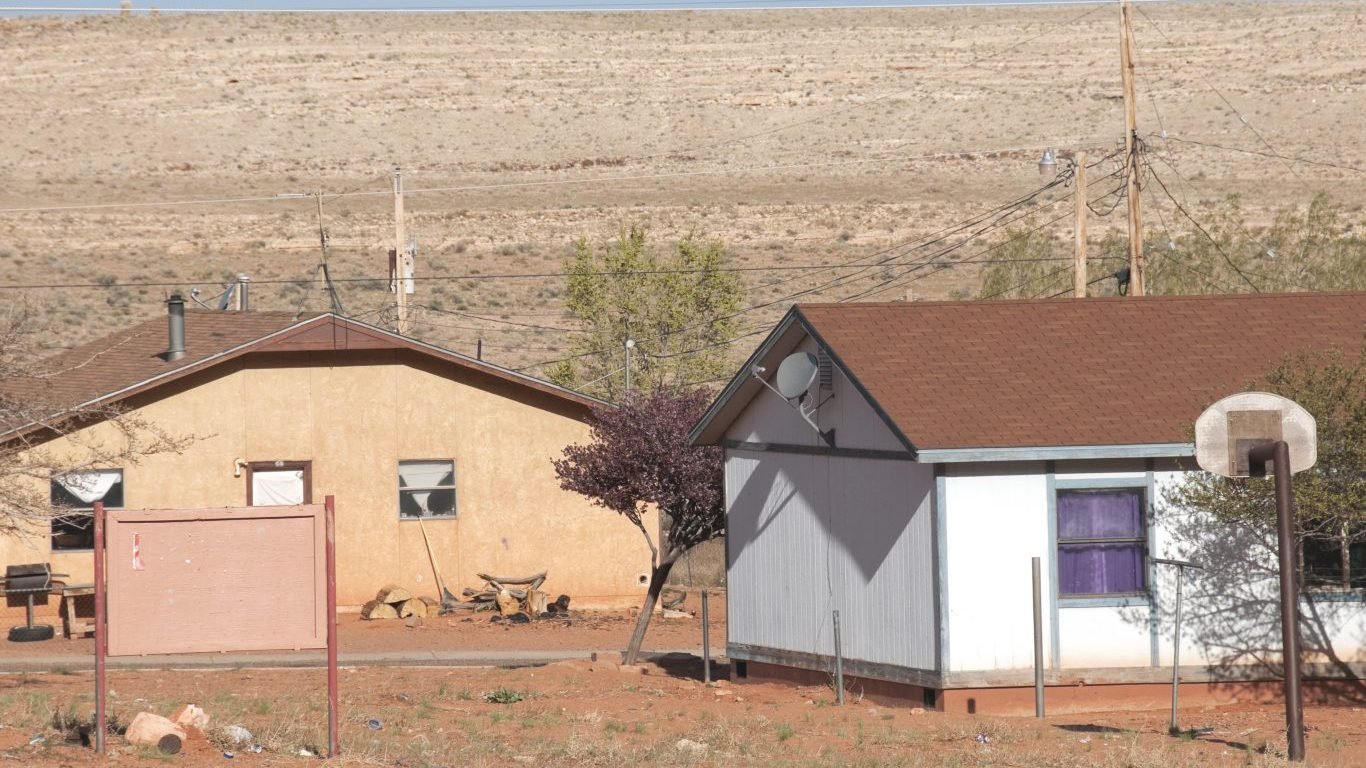

The COVID-19 pandemic profoundly affected Americans throughout 2020 by disrupting work and education, wreaking havoc on the economy, and putting a strain on personal relationships. The health crisis has exacerbated factors that people had normally pointed to as major stress sources.
About 64% of people in the U.S. say that money is a significant source of stress in their life, and just over half say they have experienced negative financial impacts due to the pandemic, according to a November 2020 Stress in America survey by the American Psychological Association.
Another common cause of stress, which is in many ways also related to money, is work. About one in two employed Americans say their job adds stress to their lives.
To identify the most stressed city in every state, 24/7 Tempo created an index that measures the likelihood that money and work will cause stress among residents of U.S. metropolitan areas. Our index included several money- and work-related factors, including unemployment, poverty, income, and commuting time among others.
Some of the cities on our list are among the most desirable cities for young Americans. But these cities have long commutes and steep housing costs, making it necessary for people to work long hours so they can stay in those cities.
Only nine of the most stressed out cities in every state have a median household income that is higher than the statewide median household income and a poverty rate that is lower than the statewide figure.
While everyone experiences some stress – and some short-lived stress can improve cognitive performance — too much stress can have many negative effects on health. Elevated levels of stress can be a sign of health problems – here are 25 symptoms people always ignore but never should.
Click here to see the most stressed out city in every state
To identify the most stressed city in every state, 24/7 Tempo created an index of data measuring the two most common sources of stress — money and work — in each state’s metropolitan areas.
To capture money-related stress inputs we reviewed poverty rates, housing affordability, and food insecurity. For work-related stress inputs we included average weekly work hours, average daily commute times in hours, and annual unemployment rates.
With the exception of food insecurity and unemployment rates, which came from the United States Department of Agriculture and the Bureau of Labor Statistics, respectively, all data used in the index came from the U.S. Census Bureau’s 2019 American Community Survey.
The incidence of violent crime in each area came from the Federal Bureau of Investigation’s 2019 Uniform Crime Report. All data are for the most recent periods available.
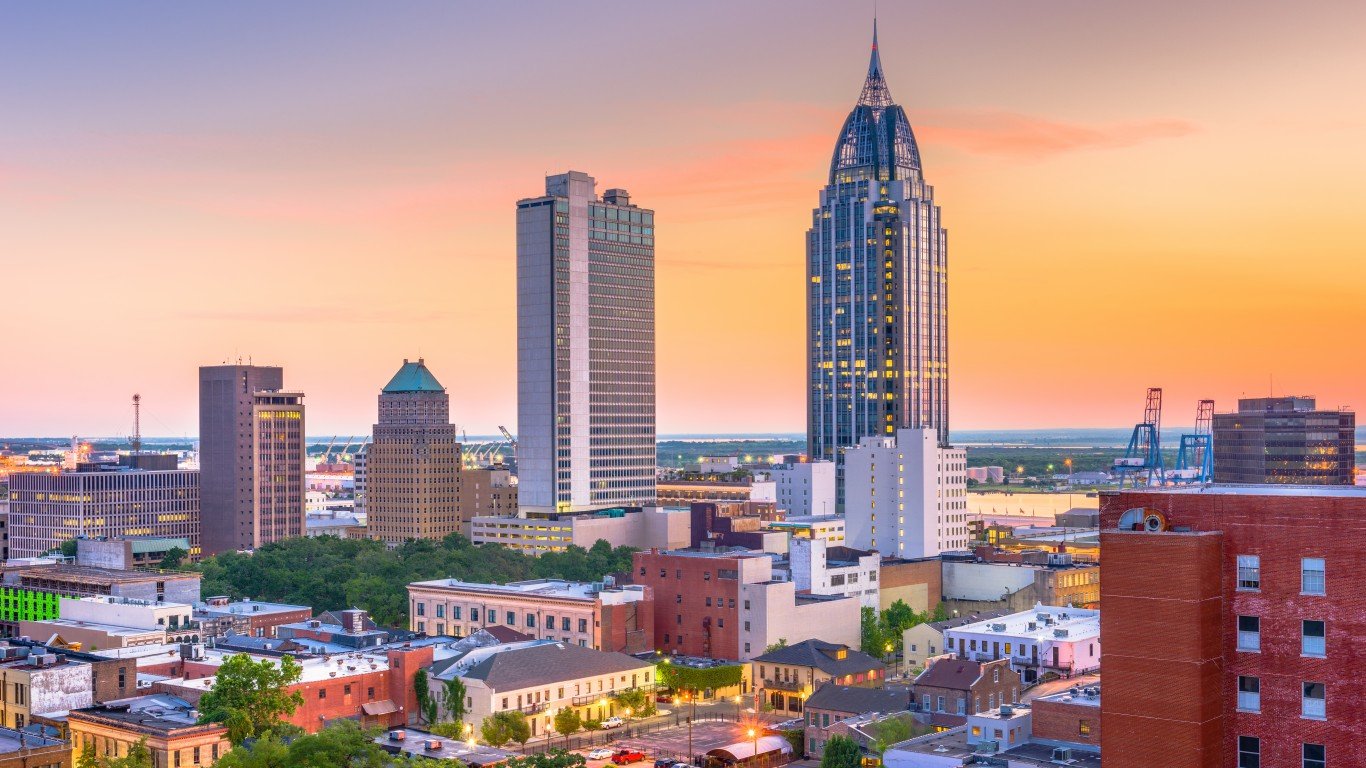
Alabama: Mobile
> Avg number of mentally unhealthy days a month: 5.2 (state: 4.9)
> Poverty rate: 17.7% (state: 15.5%)
> Median household income: $49,561 (state: $51,734)
> Adults without health insurance: 11.2% (state: 9.7%)
> People commuting 45+ min: 11.8% (state: 15.2%)
> Dec 2020 unemployment: 6.3% (state: 3.9%)
> Violent crime rate: N/A (state: 511 per 100,000 people)
> Population: 428,039 (state: 4,903,185)
[in-text-ad]

Alaska: Anchorage
> Avg number of mentally unhealthy days a month: 3.2 (state: 3.9)
> Poverty rate: 10.0% (state: 10.1%)
> Median household income: $80,676 (state: $75,463)
> Adults without health insurance: 11.5% (state: 12.2%)
> People commuting 45+ min: 10.9% (state: 8.6%)
> Dec 2020 unemployment: 5.9% (state: 5.8%)
> Violent crime rate: 1,195 per 100,000 people (state: 867 per 100,000 people)
> Population: 396,317 (state: 731,545)

Arizona: Lake Havasu City-Kingman
> Avg number of mentally unhealthy days a month: 4.8 (state: 4.0)
> Poverty rate: 15.7% (state: 13.5%)
> Median household income: $50,179 (state: $62,055)
> Adults without health insurance: 7.9% (state: 11.3%)
> People commuting 45+ min: 12.4% (state: 16.6%)
> Dec 2020 unemployment: 8.5% (state: 7.5%)
> Violent crime rate: 230 per 100,000 people (state: 455 per 100,000 people)
> Population: 212,181 (state: 7,278,717)
Arkansas: Pine Bluff
> Avg number of mentally unhealthy days a month: 4.7 (state: 5.4)
> Poverty rate: 23.6% (state: 16.2%)
> Median household income: $41,541 (state: $48,952)
> Adults without health insurance: 7.2% (state: 9.1%)
> People commuting 45+ min: 10.4% (state: 10.9%)
> Dec 2020 unemployment: 5.8% (state: 4.2%)
> Violent crime rate: 895 per 100,000 people (state: 585 per 100,000 people)
> Population: 89,437 (state: 3,017,804)
[in-text-ad-2]
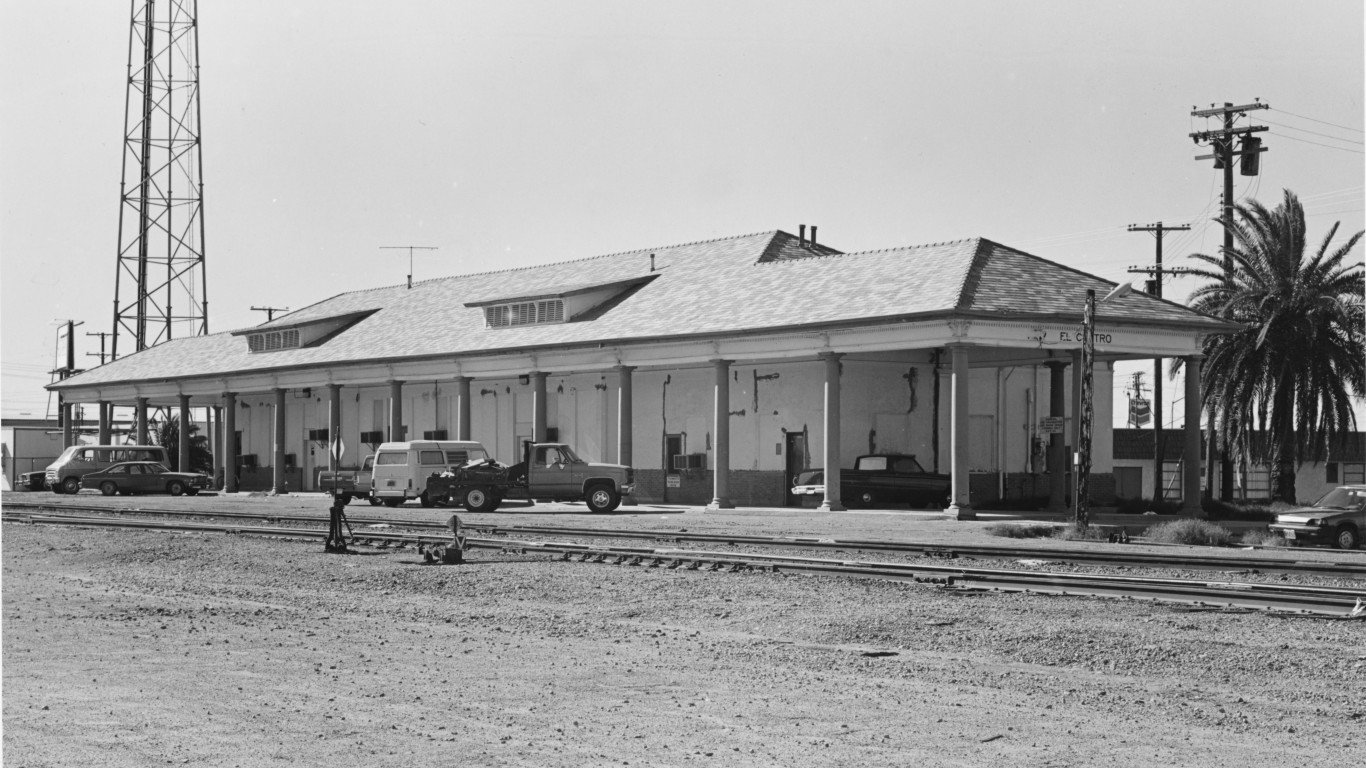
California: El Centro
> Avg number of mentally unhealthy days a month: 4.1 (state: 3.5)
> Poverty rate: 25.1% (state: 11.8%)
> Median household income: $48,472 (state: $80,440)
> Adults without health insurance: 8.3% (state: 7.7%)
> People commuting 45+ min: 13.9% (state: 22.9%)
> Dec 2020 unemployment: 19.1% (state: 9.0%)
> Violent crime rate: 339 per 100,000 people (state: 441 per 100,000 people)
> Population: 181,215 (state: 39,512,223)

Colorado: Pueblo
> Avg number of mentally unhealthy days a month: 4.3 (state: 3.8)
> Poverty rate: 17.9% (state: 9.3%)
> Median household income: $51,276 (state: $77,127)
> Adults without health insurance: 7.3% (state: 8.0%)
> People commuting 45+ min: 12.5% (state: 16.1%)
> Dec 2020 unemployment: 11.6% (state: 8.4%)
> Violent crime rate: N/A (state: 381 per 100,000 people)
> Population: 168,424 (state: 5,758,736)
[in-text-ad]

Connecticut: New Haven
> Avg number of mentally unhealthy days a month: 3.8 (state: 3.5)
> Poverty rate: 12.2% (state: 10.0%)
> Median household income: $69,751 (state: $78,833)
> Adults without health insurance: 5.9% (state: 5.9%)
> People commuting 45+ min: 14.5% (state: 16.7%)
> Dec 2020 unemployment: 8.1% (state: 8.0%)
> Violent crime rate: 273 per 100,000 people (state: 184 per 100,000 people)
> Population: 854,757 (state: 3,565,287)

Delaware: Dover
> Avg number of mentally unhealthy days a month: 4.7 (state: 4.3)
> Poverty rate: 13.0% (state: 11.3%)
> Median household income: $58,001 (state: $70,176)
> Adults without health insurance: 9.0% (state: 6.6%)
> People commuting 45+ min: 20.7% (state: 15.8%)
> Dec 2020 unemployment: 5.5% (state: 5.3%)
> Violent crime rate: 427 per 100,000 people (state: 423 per 100,000 people)
> Population: 180,786 (state: 973,764)
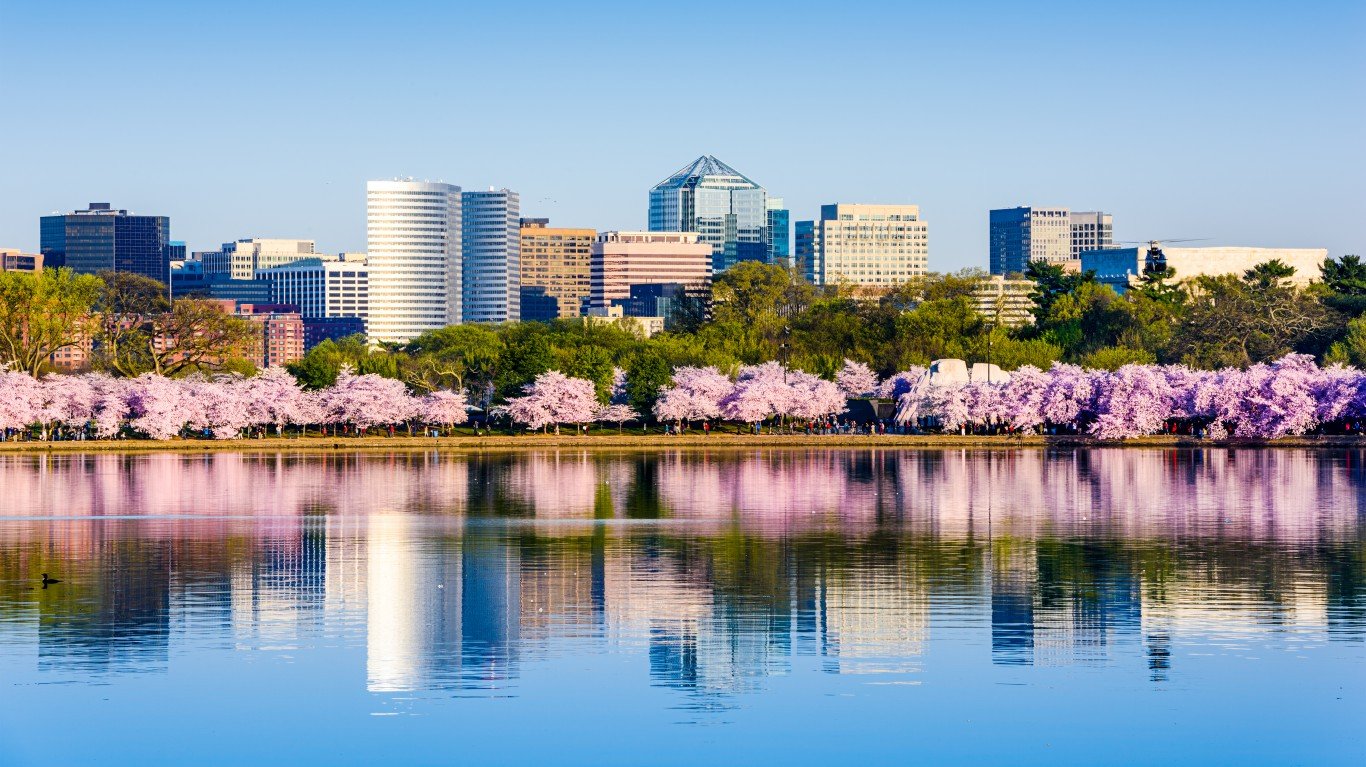
Washington DC-Arlington-Alexandria
> Avg number of mentally unhealthy days a month: 3.3 (state: N/A)
> Poverty rate: 7.5% (state: 13.5%)
> Median household income: $105,659 (state: $92,266)
> Adults without health insurance: 7.5% (state: 3.5%)
> People commuting 45+ min: 32.7% (state: 23.3%)
> Dec 2020 unemployment: 6.0% (state: 7.9%)
> Violent crime rate: N/A (state: 1,049 per 100,000 people)
> Population: 6,280,697 (state: 705,749)
[in-text-ad-2]
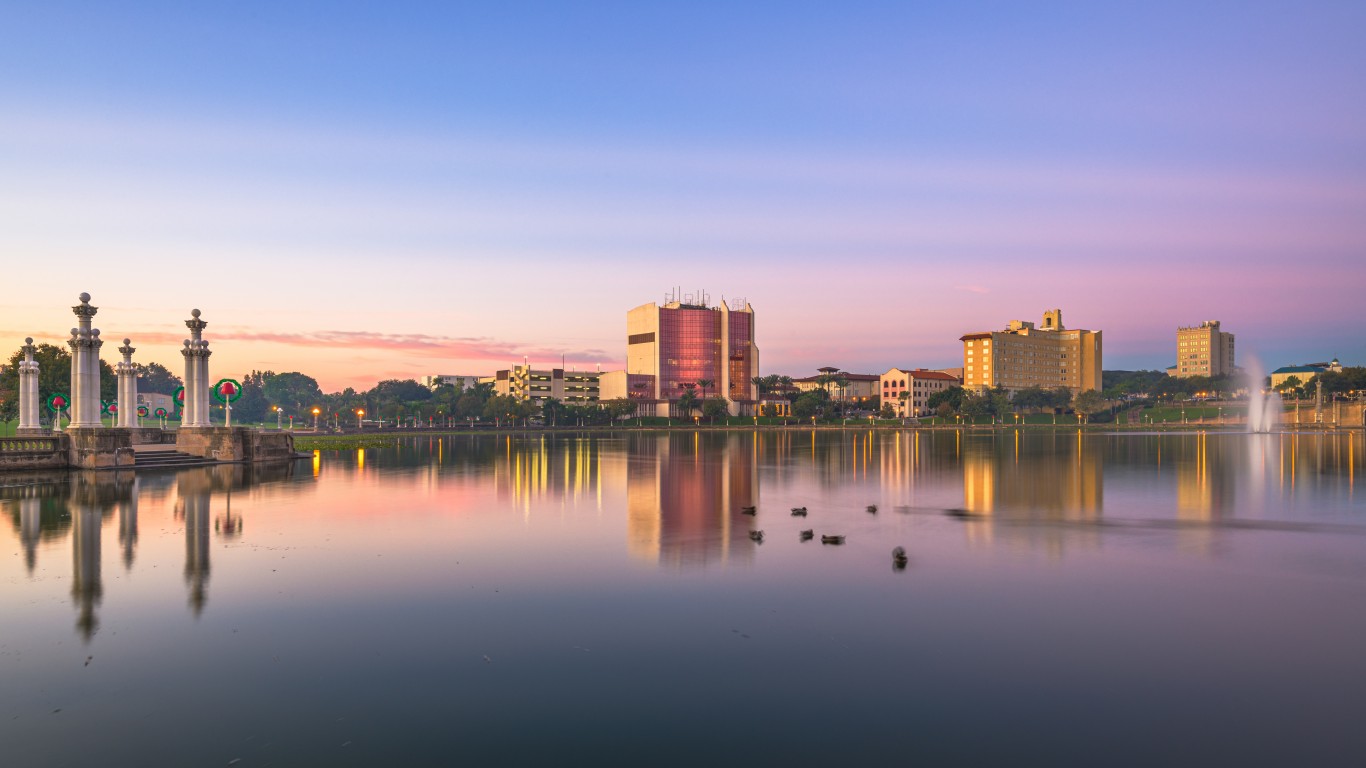
Florida: Lakeland-Winter Haven
> Avg number of mentally unhealthy days a month: 4.8 (state: 4.0)
> Poverty rate: 14.0% (state: 12.7%)
> Median household income: $51,833 (state: $59,227)
> Adults without health insurance: 13.9% (state: 13.2%)
> People commuting 45+ min: 22.6% (state: 18.7%)
> Dec 2020 unemployment: 7.1% (state: 6.1%)
> Violent crime rate: 277 per 100,000 people (state: 378 per 100,000 people)
> Population: 724,777 (state: 21,477,737)

Georgia: Albany
> Avg number of mentally unhealthy days a month: 4.2 (state: 3.9)
> Poverty rate: 22.6% (state: 13.3%)
> Median household income: $40,625 (state: $61,980)
> Adults without health insurance: 17.0% (state: 13.4%)
> People commuting 45+ min: 8.3% (state: 21.5%)
> Dec 2020 unemployment: 7.1% (state: 5.6%)
> Violent crime rate: 718 per 100,000 people (state: 341 per 100,000 people)
> Population: 147,384 (state: 10,617,423)
[in-text-ad]

Hawaii: Kahului-Wailuku-Lahaina
> Avg number of mentally unhealthy days a month: 3.4 (state: 3.2)
> Poverty rate: 11.9% (state: 9.3%)
> Median household income: $80,754 (state: $83,102)
> Adults without health insurance: 6.3% (state: 4.2%)
> People commuting 45+ min: 8.5% (state: 20.0%)
> Dec 2020 unemployment: 13.2% (state: 9.3%)
> Violent crime rate: 268 per 100,000 people (state: 285 per 100,000 people)
> Population: 167,488 (state: 1,415,872)

Idaho: Coeur d’Alene
> Avg number of mentally unhealthy days a month: 3.9 (state: 3.6)
> Poverty rate: 10.0% (state: 11.2%)
> Median household income: $62,579 (state: $60,999)
> Adults without health insurance: 11.1% (state: 10.8%)
> People commuting 45+ min: 9.2% (state: 10.2%)
> Dec 2020 unemployment: 5.7% (state: 4.4%)
> Violent crime rate: 219 per 100,000 people (state: 224 per 100,000 people)
> Population: 165,697 (state: 1,787,065)
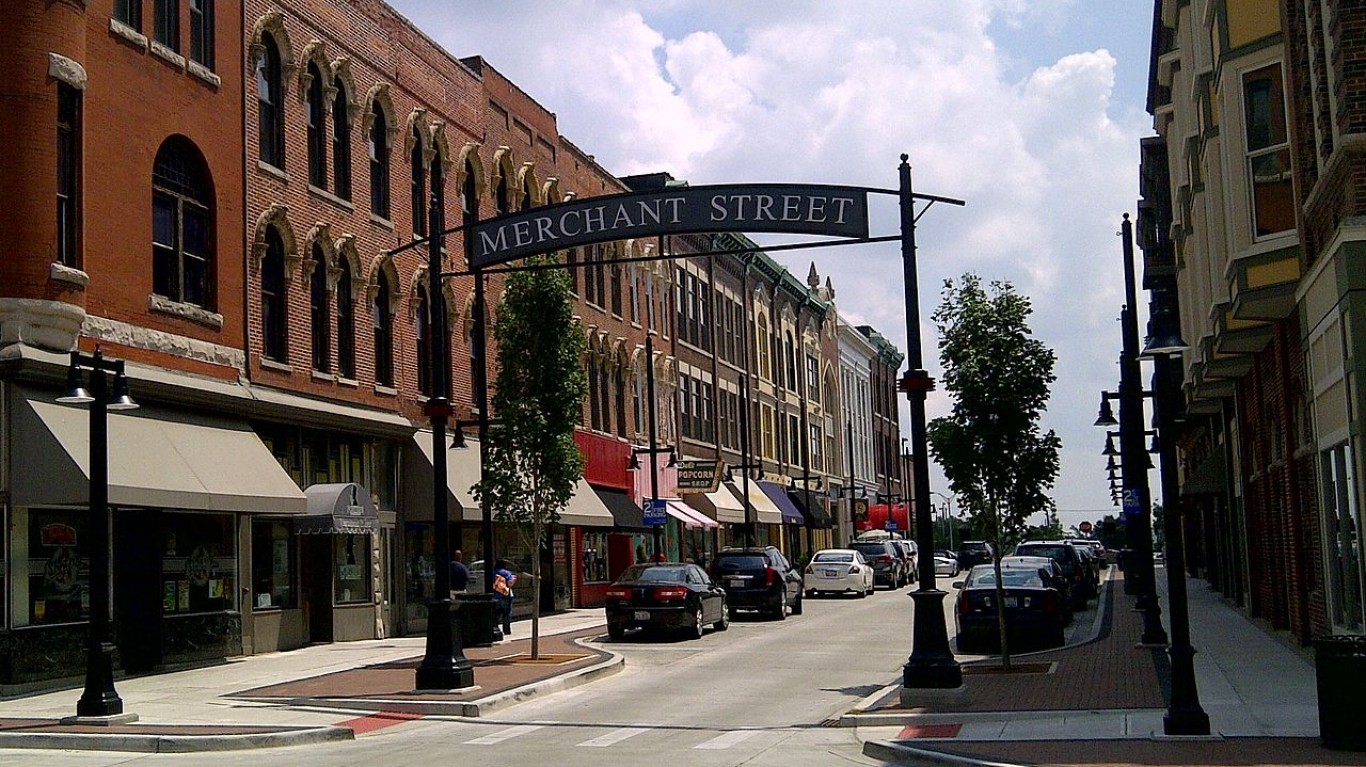
Illinois: Decatur
> Avg number of mentally unhealthy days a month: 4.2 (state: 3.8)
> Poverty rate: 17.4% (state: 11.5%)
> Median household income: $50,839 (state: $69,187)
> Adults without health insurance: 4.9% (state: 7.4%)
> People commuting 45+ min: 8.3% (state: 22.8%)
> Dec 2020 unemployment: 8.2% (state: 7.6%)
> Violent crime rate: 419 per 100,000 people (state: 407 per 100,000 people)
> Population: 104,009 (state: 12,671,821)
[in-text-ad-2]
Indiana: Michigan City-La Porte
> Avg number of mentally unhealthy days a month: 4.5 (state: 4.7)
> Poverty rate: 13.7% (state: 11.9%)
> Median household income: $56,019 (state: $57,603)
> Adults without health insurance: 7.8% (state: 8.7%)
> People commuting 45+ min: 18.1% (state: 13.1%)
> Dec 2020 unemployment: 6.2% (state: 4.3%)
> Violent crime rate: N/A (state: 371 per 100,000 people)
> Population: 109,888 (state: 6,732,219)

Iowa: Davenport-Moline-Rock Island
> Avg number of mentally unhealthy days a month: 3.8 (state: 3.6)
> Poverty rate: 11.3% (state: 11.2%)
> Median household income: $62,001 (state: $61,691)
> Adults without health insurance: 5.8% (state: 5.0%)
> People commuting 45+ min: 7.8% (state: 8.0%)
> Dec 2020 unemployment: 5.3% (state: 3.1%)
> Violent crime rate: 366 per 100,000 people (state: 267 per 100,000 people)
> Population: 378,923 (state: 3,155,070)
[in-text-ad]

Kansas: Wichita
> Avg number of mentally unhealthy days a month: 3.9 (state: 3.7)
> Poverty rate: 11.6% (state: 11.4%)
> Median household income: $59,779 (state: $62,087)
> Adults without health insurance: 10.4% (state: 9.2%)
> People commuting 45+ min: 5.8% (state: 7.8%)
> Dec 2020 unemployment: 4.7% (state: 3.8%)
> Violent crime rate: 781 per 100,000 people (state: 411 per 100,000 people)
> Population: 640,218 (state: 2,913,314)
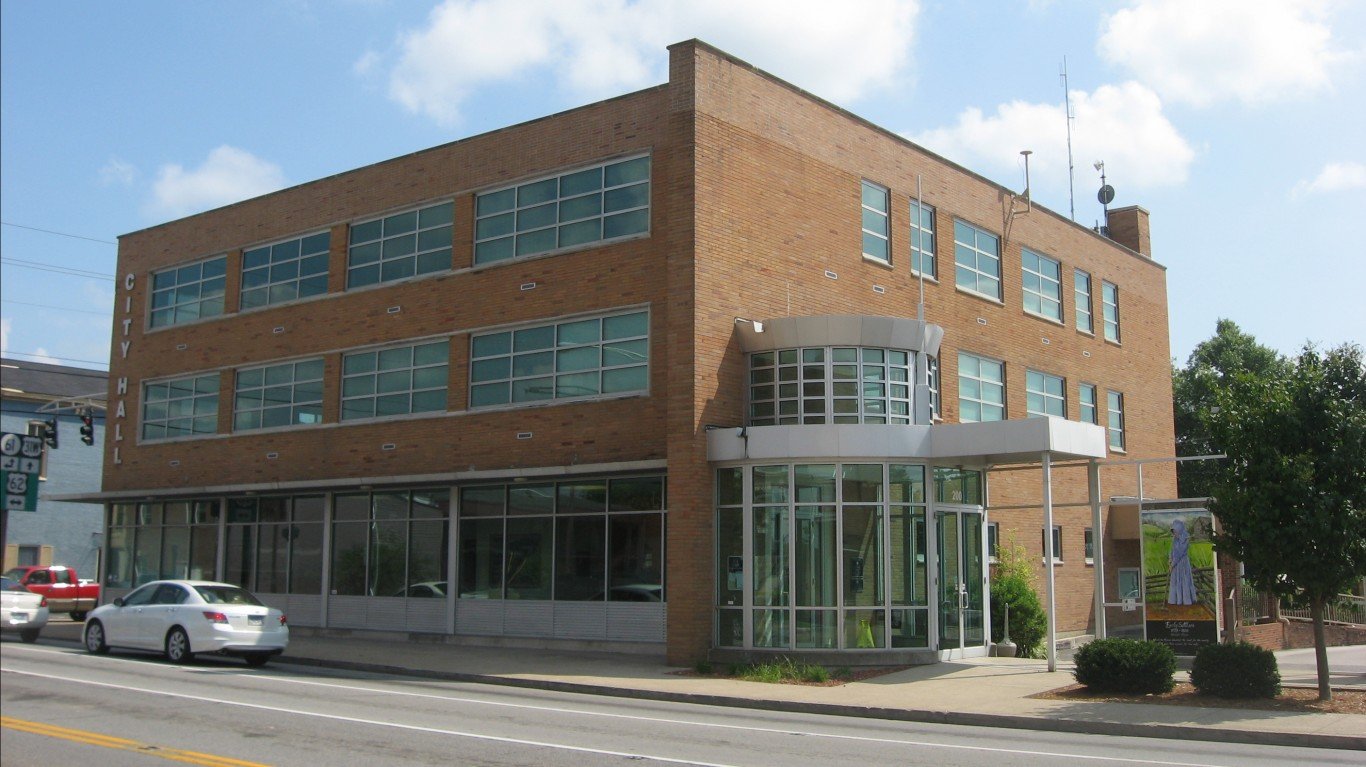
Kentucky: Elizabethtown-Fort Knox
> Avg number of mentally unhealthy days a month: 4.6 (state: 5.0)
> Poverty rate: 11.1% (state: 16.3%)
> Median household income: $55,246 (state: $52,295)
> Adults without health insurance: 4.8% (state: 6.4%)
> People commuting 45+ min: 17.0% (state: 12.8%)
> Dec 2020 unemployment: 5.8% (state: 6.0%)
> Violent crime rate: 100 per 100,000 people (state: 217 per 100,000 people)
> Population: 154,713 (state: 4,467,673)
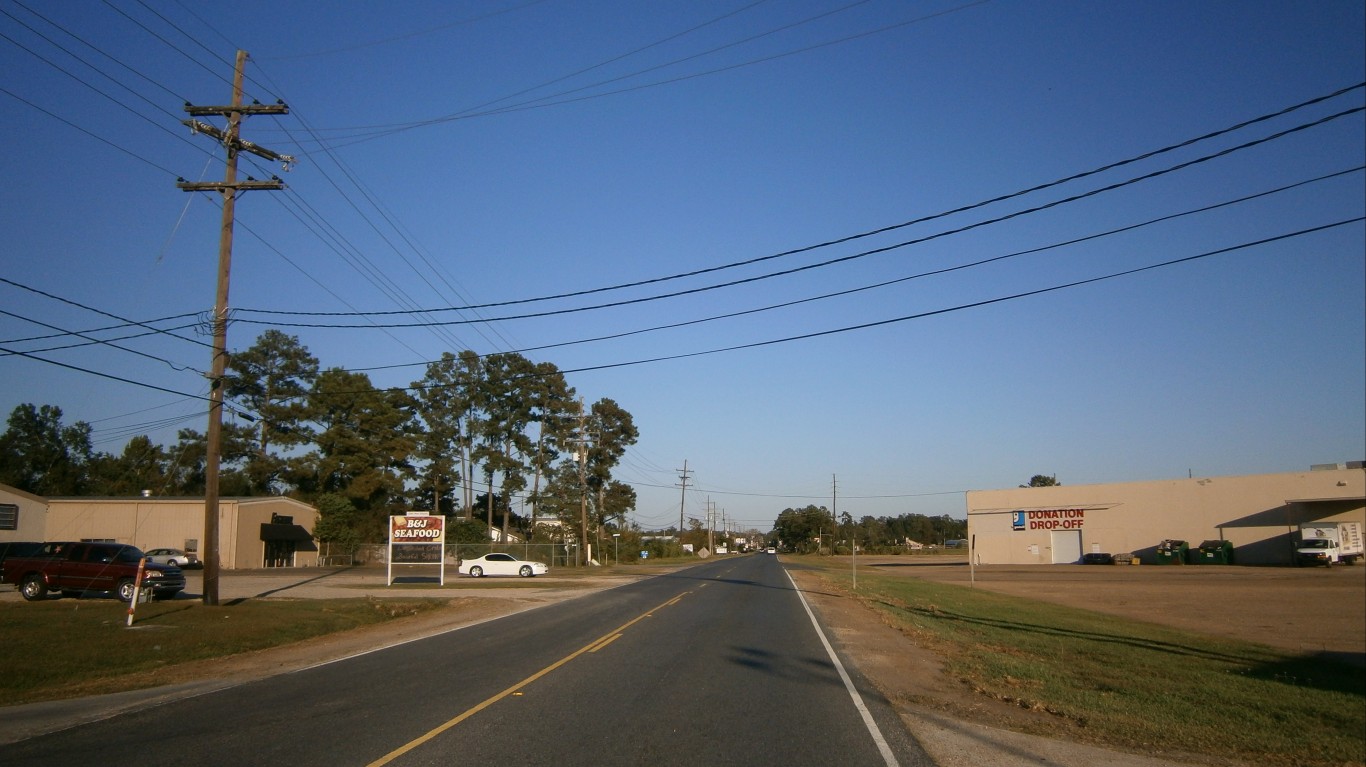
Louisiana: Hammond
> Avg number of mentally unhealthy days a month: 5.0 (state: 5.1)
> Poverty rate: 22.9% (state: 19.0%)
> Median household income: $47,825 (state: $51,073)
> Adults without health insurance: 9.0% (state: 8.9%)
> People commuting 45+ min: 29.4% (state: 15.9%)
> Dec 2020 unemployment: 8.5% (state: 7.2%)
> Violent crime rate: N/A (state: 549 per 100,000 people)
> Population: 134,758 (state: 4,648,794)
[in-text-ad-2]

Maine: Bangor
> Avg number of mentally unhealthy days a month: 4.6 (state: 4.5)
> Poverty rate: 12.1% (state: 10.9%)
> Median household income: $50,449 (state: $58,924)
> Adults without health insurance: 9.6% (state: 8.0%)
> People commuting 45+ min: 12.4% (state: 14.1%)
> Dec 2020 unemployment: 4.4% (state: 4.9%)
> Violent crime rate: 44 per 100,000 people (state: 115 per 100,000 people)
> Population: 152,148 (state: 1,344,212)
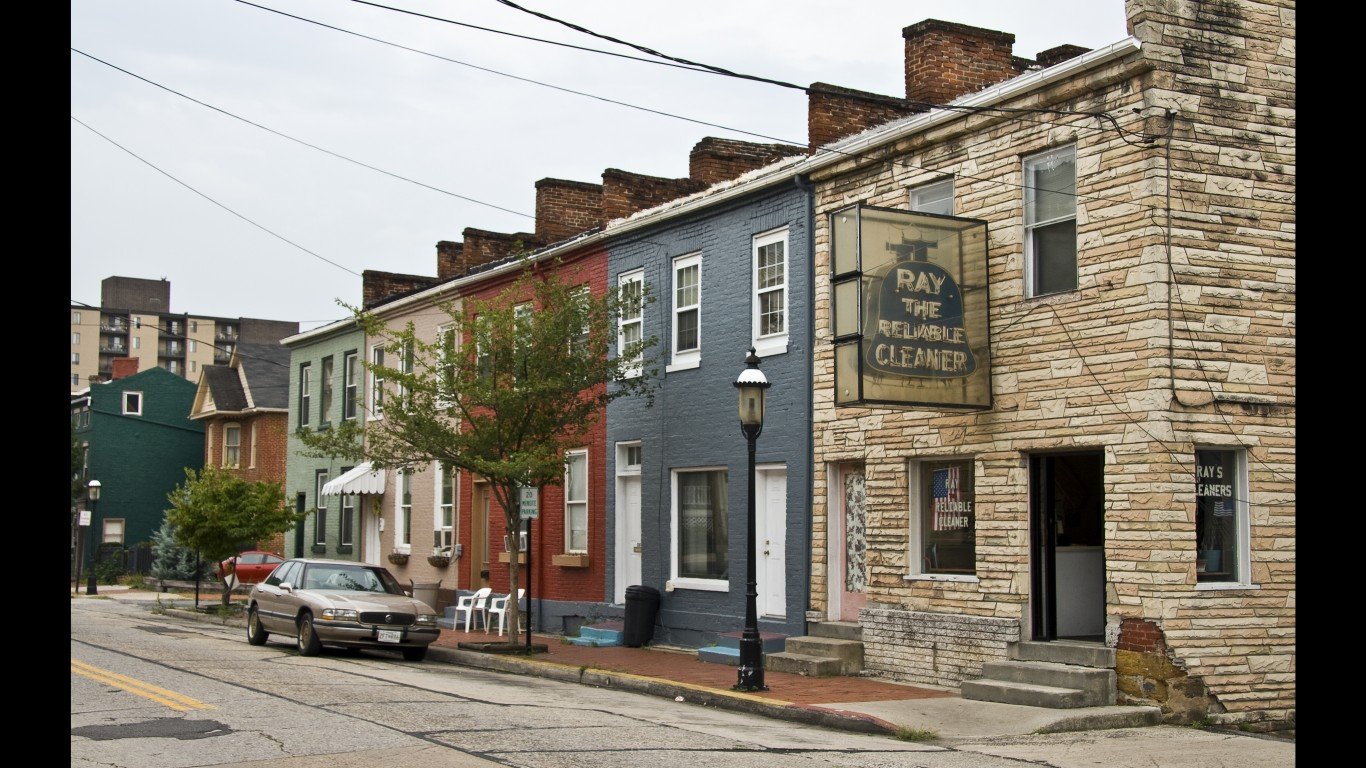
Maryland: Cumberland
> Avg number of mentally unhealthy days a month: 4.8 (state: 3.8)
> Poverty rate: 13.9% (state: 9.0%)
> Median household income: $49,729 (state: $86,738)
> Adults without health insurance: 4.8% (state: 6.0%)
> People commuting 45+ min: 12.6% (state: 29.1%)
> Dec 2020 unemployment: 7.0% (state: 6.3%)
> Violent crime rate: 275 per 100,000 people (state: 454 per 100,000 people)
> Population: 97,284 (state: 6,045,680)
[in-text-ad]

Massachusetts: Springfield
> Avg number of mentally unhealthy days a month: 4.5 (state: 4.0)
> Poverty rate: 12.6% (state: 9.4%)
> Median household income: $62,346 (state: $85,843)
> Adults without health insurance: 3.3% (state: 3.0%)
> People commuting 45+ min: 11.3% (state: 25.2%)
> Dec 2020 unemployment: 8.8% (state: 7.4%)
> Violent crime rate: 472 per 100,000 people (state: 328 per 100,000 people)
> Population: 697,382 (state: 6,892,503)

Michigan: Flint
> Avg number of mentally unhealthy days a month: 4.6 (state: 4.4)
> Poverty rate: 16.5% (state: 13.0%)
> Median household income: $50,389 (state: $59,584)
> Adults without health insurance: 5.3% (state: 5.8%)
> People commuting 45+ min: 18.9% (state: 14.1%)
> Dec 2020 unemployment: 7.0% (state: 7.5%)
> Violent crime rate: 580 per 100,000 people (state: 437 per 100,000 people)
> Population: 405,813 (state: 9,986,857)

Minnesota: Duluth
> Avg number of mentally unhealthy days a month: 3.5 (state: 3.1)
> Poverty rate: 12.4% (state: 9.0%)
> Median household income: $60,316 (state: $74,593)
> Adults without health insurance: 4.3% (state: 4.9%)
> People commuting 45+ min: 7.8% (state: 13.0%)
> Dec 2020 unemployment: 5.7% (state: 4.4%)
> Violent crime rate: 209 per 100,000 people (state: 236 per 100,000 people)
> Population: 289,383 (state: 5,639,632)
[in-text-ad-2]

Mississippi: Gulfport-Biloxi-Pascagoula
> Avg number of mentally unhealthy days a month: 4.4 (state: 5.0)
> Poverty rate: 16.4% (state: 19.6%)
> Median household income: $50,642 (state: $45,792)
> Adults without health insurance: 13.1% (state: 13.0%)
> People commuting 45+ min: 13.7% (state: 13.2%)
> Dec 2020 unemployment: 6.6% (state: 6.2%)
> Violent crime rate: 221 per 100,000 people (state: 278 per 100,000 people)
> Population: 417,665 (state: 2,976,149)
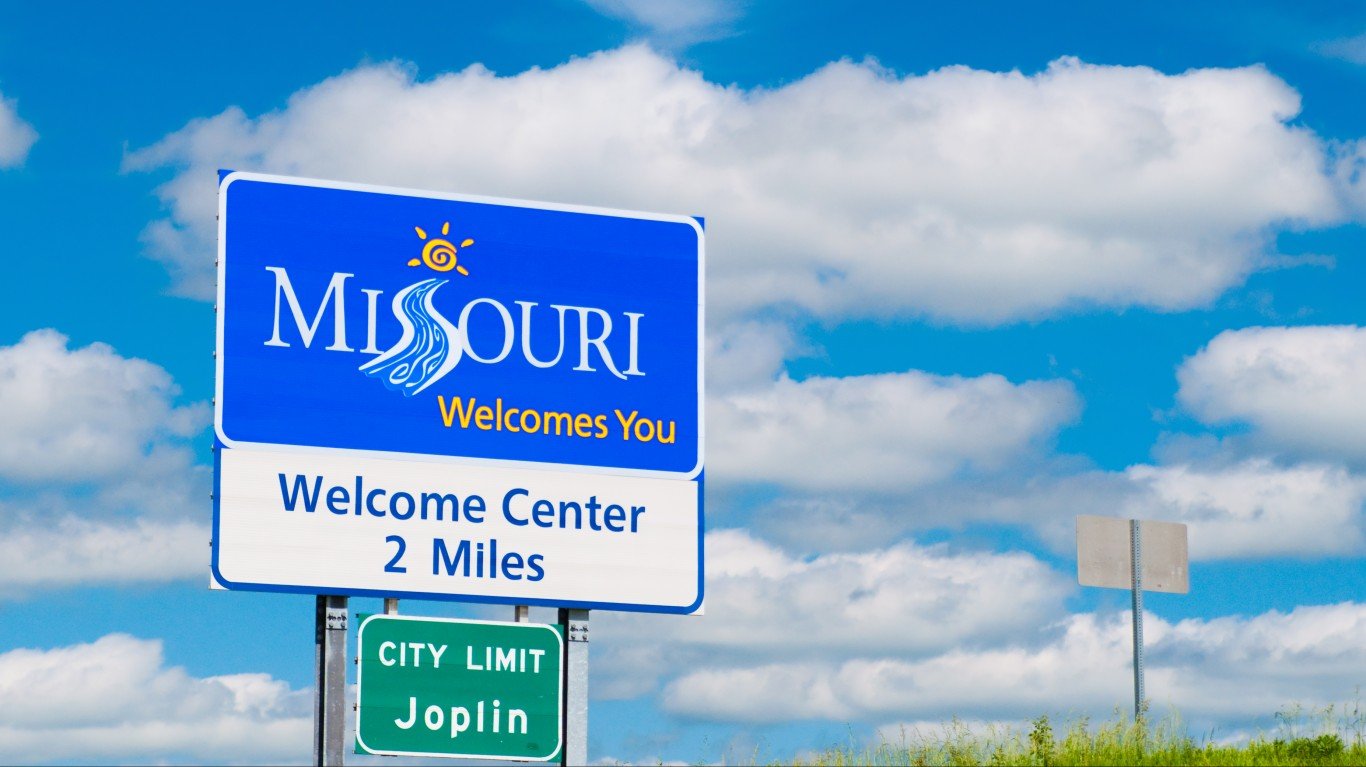
Missouri: Joplin
> Avg number of mentally unhealthy days a month: 4.6 (state: 4.4)
> Poverty rate: 18.0% (state: 12.9%)
> Median household income: $48,909 (state: $57,409)
> Adults without health insurance: 15.2% (state: 10.0%)
> People commuting 45+ min: 6.7% (state: 12.4%)
> Dec 2020 unemployment: 5.5% (state: 5.8%)
> Violent crime rate: 331 per 100,000 people (state: 495 per 100,000 people)
> Population: 179,564 (state: 6,137,428)
[in-text-ad]

Montana: Great Falls
> Avg number of mentally unhealthy days a month: 3.8 (state: 3.7)
> Poverty rate: 15.4% (state: 12.6%)
> Median household income: $51,227 (state: $57,153)
> Adults without health insurance: 6.9% (state: 8.3%)
> People commuting 45+ min: 3.7% (state: 8.4%)
> Dec 2020 unemployment: 4.3% (state: 4.4%)
> Violent crime rate: N/A (state: 405 per 100,000 people)
> Population: 81,366 (state: 1,068,778)

Nebraska: Grand Island
> Avg number of mentally unhealthy days a month: 3.5 (state: 3.5)
> Poverty rate: 10.3% (state: 9.9%)
> Median household income: $55,907 (state: $63,229)
> Adults without health insurance: 10.5% (state: 8.3%)
> People commuting 45+ min: 8.3% (state: 7.5%)
> Dec 2020 unemployment: 4.6% (state: 3.0%)
> Violent crime rate: 376 per 100,000 people (state: 301 per 100,000 people)
> Population: 75,553 (state: 1,934,408)

Nevada: Las Vegas-Henderson-Paradise
> Avg number of mentally unhealthy days a month: 3.7 (state: 3.5)
> Poverty rate: 12.8% (state: 12.5%)
> Median household income: $62,107 (state: $63,276)
> Adults without health insurance: 12.2% (state: 11.4%)
> People commuting 45+ min: 10.7% (state: 11.5%)
> Dec 2020 unemployment: 10.5% (state: 9.2%)
> Violent crime rate: 526 per 100,000 people (state: 494 per 100,000 people)
> Population: 2,266,715 (state: 3,080,156)
[in-text-ad-2]

New Hampshire: Manchester
> Avg number of mentally unhealthy days a month: 3.7 (state: 4.1)
> Poverty rate: 7.3% (state: 7.3%)
> Median household income: $83,626 (state: $77,933)
> Adults without health insurance: 6.8% (state: 6.3%)
> People commuting 45+ min: 18.8% (state: 18.9%)
> Dec 2020 unemployment: 4.1% (state: 4.0%)
> Violent crime rate: 230 per 100,000 people (state: 153 per 100,000 people)
> Population: 417,025 (state: 1,359,711)

New Jersey: Atlantic City-Hammonton
> Avg number of mentally unhealthy days a month: 4.4 (state: 3.9)
> Poverty rate: 11.1% (state: 9.2%)
> Median household income: $63,389 (state: $85,751)
> Adults without health insurance: 8.7% (state: 7.9%)
> People commuting 45+ min: 13.7% (state: 27.5%)
> Dec 2020 unemployment: 11.9% (state: 7.6%)
> Violent crime rate: 255 per 100,000 people (state: 207 per 100,000 people)
> Population: 263,670 (state: 8,882,190)
[in-text-ad]

New Mexico: Farmington
> Avg number of mentally unhealthy days a month: 4.9 (state: 4.5)
> Poverty rate: 21.2% (state: 18.2%)
> Median household income: $44,321 (state: $51,945)
> Adults without health insurance: 13.9% (state: 10.0%)
> People commuting 45+ min: 11.8% (state: 11.3%)
> Dec 2020 unemployment: 9.2% (state: 8.2%)
> Violent crime rate: N/A (state: 832 per 100,000 people)
> Population: 123,958 (state: 2,096,829)

New York: Watertown-Fort Drum
> Avg number of mentally unhealthy days a month: 4.1 (state: 3.9)
> Poverty rate: 15.5% (state: 13.0%)
> Median household income: $53,917 (state: $72,108)
> Adults without health insurance: 5.0% (state: 5.2%)
> People commuting 45+ min: 7.6% (state: 29.9%)
> Dec 2020 unemployment: 5.4% (state: 8.2%)
> Violent crime rate: 220 per 100,000 people (state: 359 per 100,000 people)
> Population: 109,834 (state: 19,453,561)
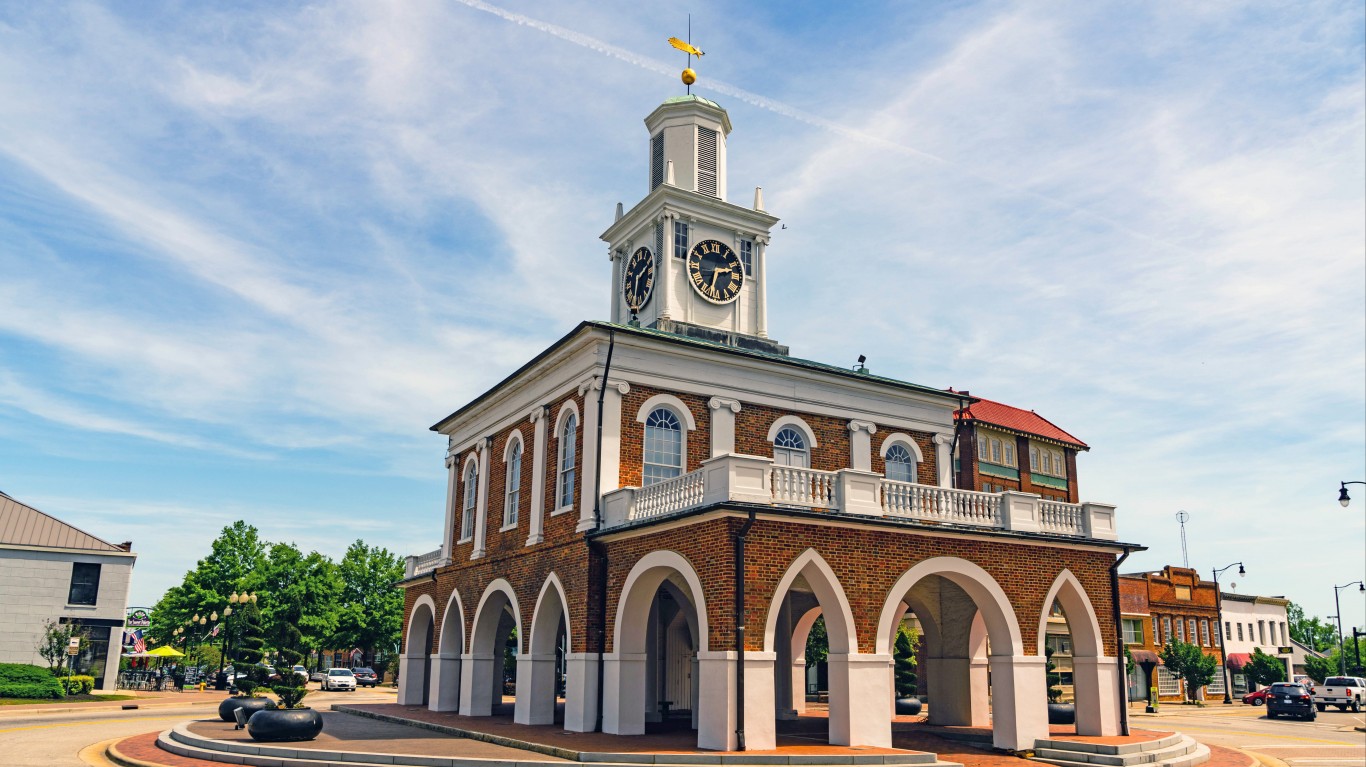
North Carolina: Fayetteville
> Avg number of mentally unhealthy days a month: 4.4 (state: 4.1)
> Poverty rate: 17.9% (state: 13.6%)
> Median household income: $47,597 (state: $57,341)
> Adults without health insurance: 12.3% (state: 11.3%)
> People commuting 45+ min: 14.4% (state: 14.6%)
> Dec 2020 unemployment: 8.4% (state: 6.2%)
> Violent crime rate: N/A (state: 372 per 100,000 people)
> Population: 526,719 (state: 10,488,084)
[in-text-ad-2]
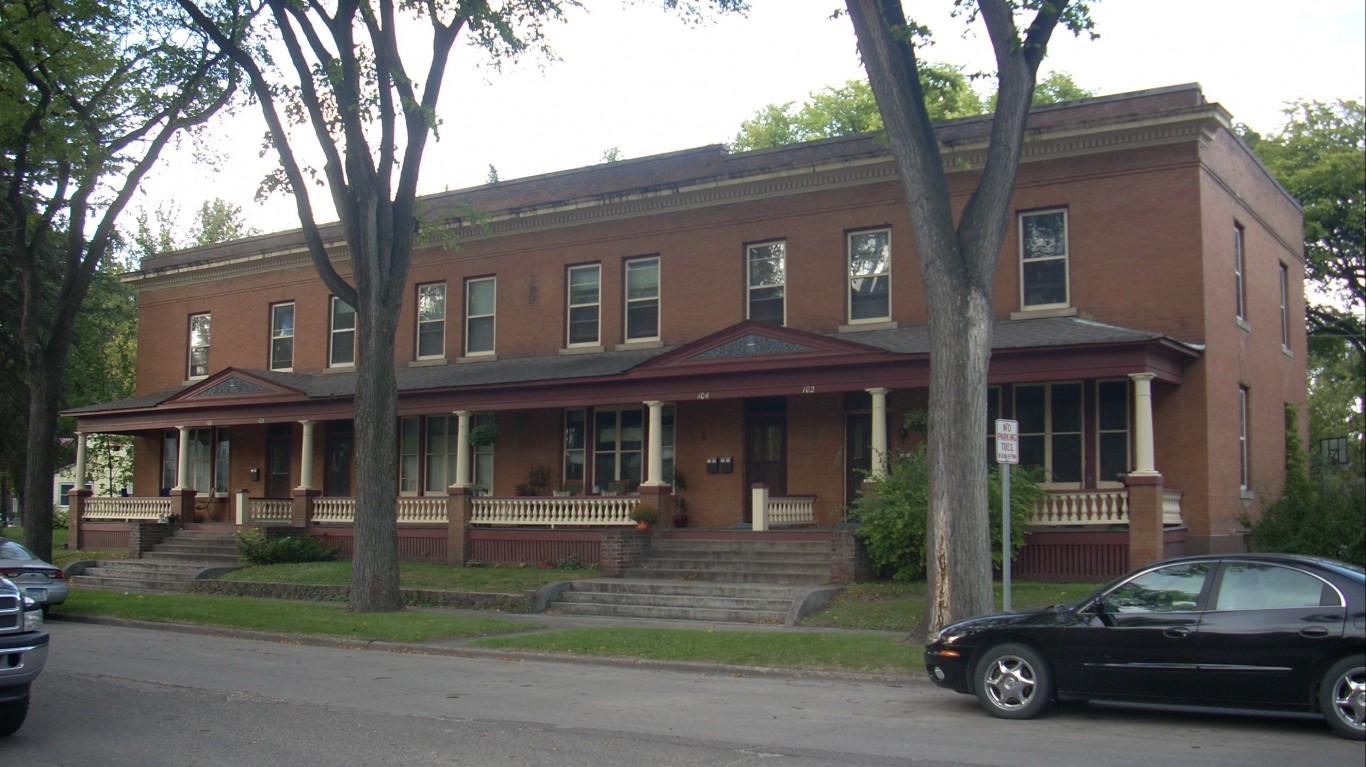
North Dakota: Grand Forks
> Avg number of mentally unhealthy days a month: 3.5 (state: 3.5)
> Poverty rate: 13.9% (state: 10.6%)
> Median household income: $57,301 (state: $64,577)
> Adults without health insurance: 4.1% (state: 6.9%)
> People commuting 45+ min: 6.6% (state: 7.3%)
> Dec 2020 unemployment: 4.0% (state: 4.1%)
> Violent crime rate: 251 per 100,000 people (state: 285 per 100,000 people)
> Population: 100,815 (state: 762,062)
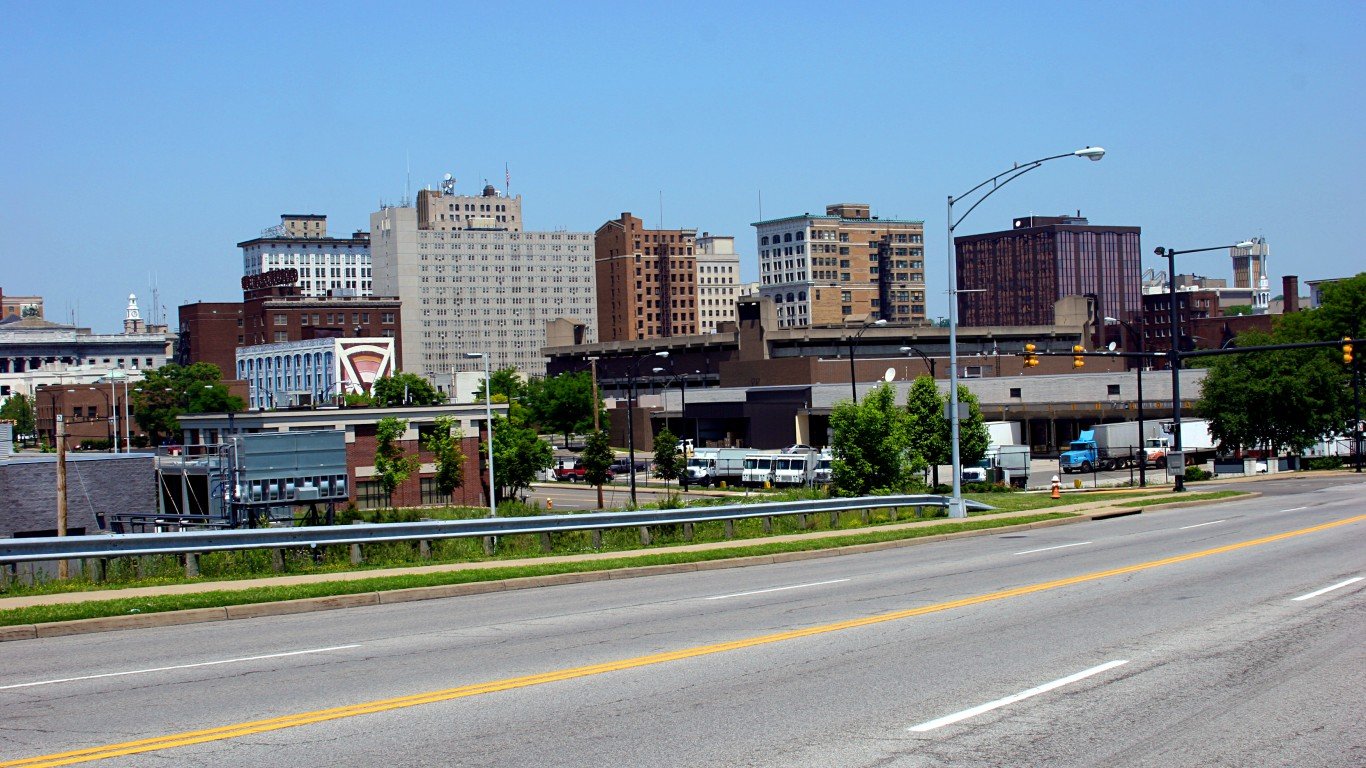
Ohio: Youngstown-Warren-Boardman
> Avg number of mentally unhealthy days a month: 4.6 (state: 4.6)
> Poverty rate: 16.2% (state: 13.1%)
> Median household income: $48,558 (state: $58,642)
> Adults without health insurance: 6.6% (state: 6.6%)
> People commuting 45+ min: 12.6% (state: 12.2%)
> Dec 2020 unemployment: 7.8% (state: 5.5%)
> Violent crime rate: N/A (state: 293 per 100,000 people)
> Population: 536,081 (state: 11,689,100)
[in-text-ad]

Oklahoma: Lawton
> Avg number of mentally unhealthy days a month: 4.6 (state: 4.9)
> Poverty rate: 17.8% (state: 15.2%)
> Median household income: $51,332 (state: $54,449)
> Adults without health insurance: 13.5% (state: 14.3%)
> People commuting 45+ min: 7.6% (state: 10.9%)
> Dec 2020 unemployment: 5.3% (state: 5.3%)
> Violent crime rate: 716 per 100,000 people (state: 432 per 100,000 people)
> Population: 126,043 (state: 3,956,971)
Oregon: Grants Pass
> Avg number of mentally unhealthy days a month: 5.1 (state: 4.8)
> Poverty rate: 15.7% (state: 11.4%)
> Median household income: $47,573 (state: $67,058)
> Adults without health insurance: 12.5% (state: 7.2%)
> People commuting 45+ min: 8.1% (state: 13.7%)
> Dec 2020 unemployment: 7.0% (state: 6.4%)
> Violent crime rate: 239 per 100,000 people (state: 284 per 100,000 people)
> Population: 87,487 (state: 4,217,737)
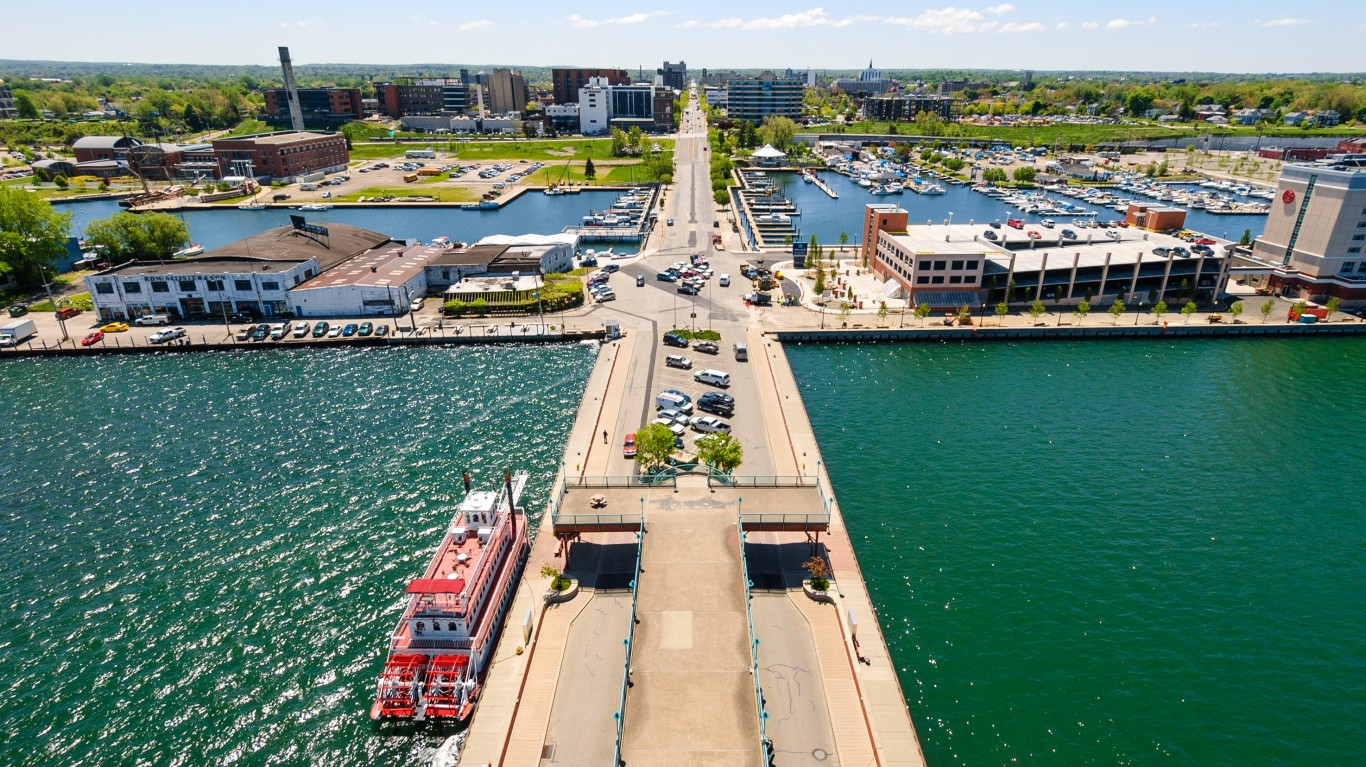
Pennsylvania: Erie
> Avg number of mentally unhealthy days a month: 4.8 (state: 4.4)
> Poverty rate: 17.4% (state: 12.0%)
> Median household income: $51,818 (state: $63,463)
> Adults without health insurance: 4.8% (state: 5.8%)
> People commuting 45+ min: 6.0% (state: 18.8%)
> Dec 2020 unemployment: 7.7% (state: 6.7%)
> Violent crime rate: 299 per 100,000 people (state: 306 per 100,000 people)
> Population: 269,728 (state: 12,801,989)
[in-text-ad-2]

Rhode Island: Providence-Warwick
> Avg number of mentally unhealthy days a month: 4.3 (state: 4.6)
> Poverty rate: 11.0% (state: 10.8%)
> Median household income: $70,967 (state: $71,169)
> Adults without health insurance: 3.7% (state: 4.1%)
> People commuting 45+ min: 17.8% (state: 14.8%)
> Dec 2020 unemployment: 7.9% (state: 8.1%)
> Violent crime rate: 283 per 100,000 people (state: 221 per 100,000 people)
> Population: 1,624,578 (state: 1,059,361)
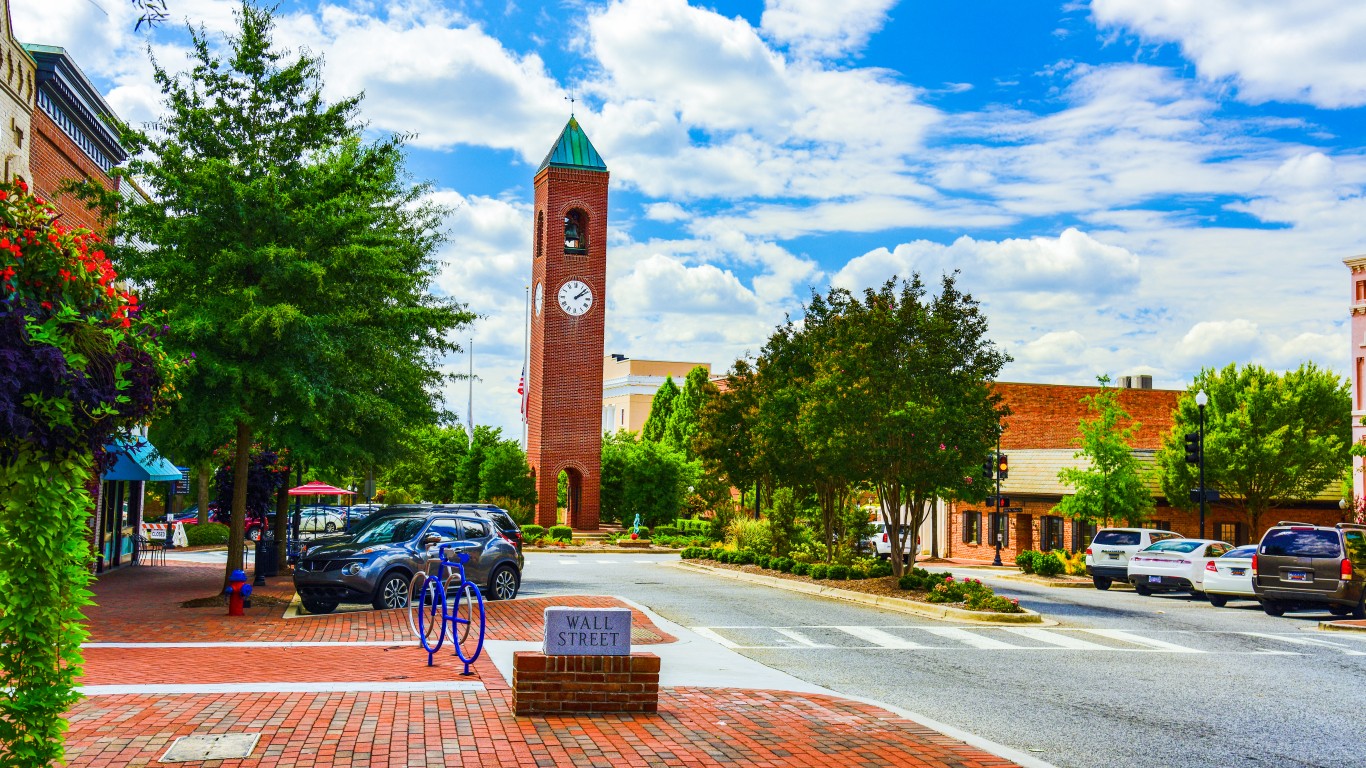
South Carolina: Spartanburg
> Avg number of mentally unhealthy days a month: 4.7 (state: 4.5)
> Poverty rate: 12.8% (state: 13.8%)
> Median household income: $55,339 (state: $56,227)
> Adults without health insurance: 9.7% (state: 10.8%)
> People commuting 45+ min: 10.6% (state: 15.3%)
> Dec 2020 unemployment: 4.7% (state: 4.6%)
> Violent crime rate: 503 per 100,000 people (state: 511 per 100,000 people)
> Population: 319,785 (state: 5,148,714)
[in-text-ad]
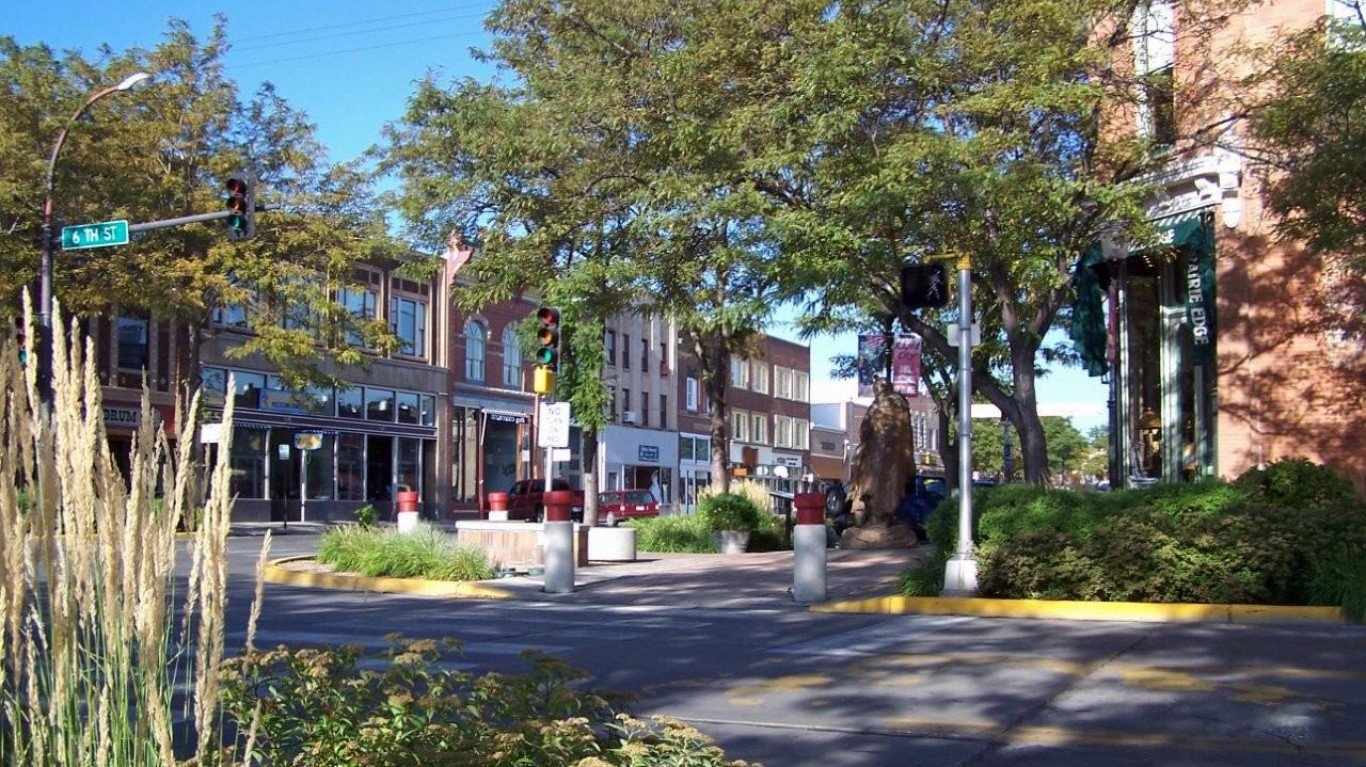
South Dakota: Rapid City
> Avg number of mentally unhealthy days a month: 3.1 (state: 3.2)
> Poverty rate: 11.0% (state: 11.9%)
> Median household income: $58,361 (state: $59,533)
> Adults without health insurance: 10.6% (state: 10.2%)
> People commuting 45+ min: 6.9% (state: 6.7%)
> Dec 2020 unemployment: 3.4% (state: 3.0%)
> Violent crime rate: 532 per 100,000 people (state: 399 per 100,000 people)
> Population: 142,191 (state: 884,659)
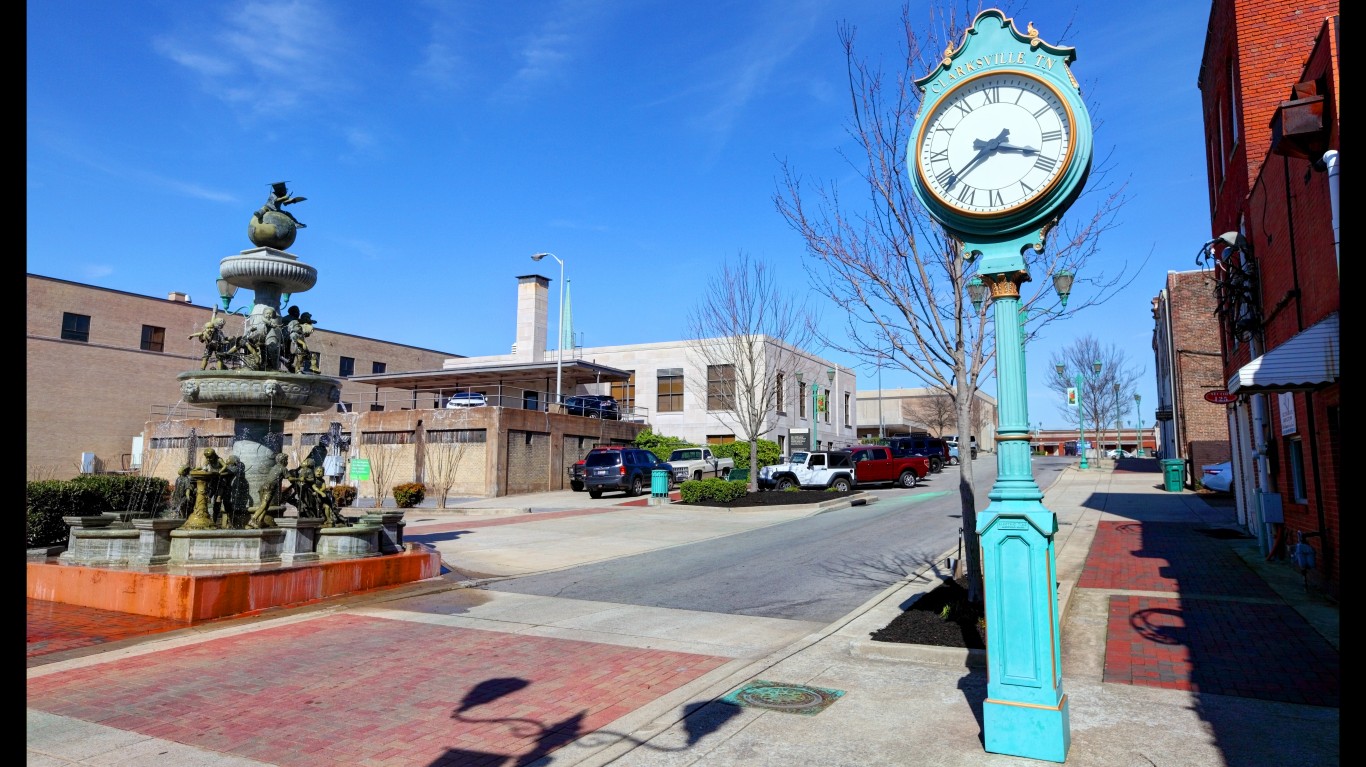
Tennessee: Clarksville
> Avg number of mentally unhealthy days a month: 4.6 (state: 4.4)
> Poverty rate: 14.3% (state: 13.9%)
> Median household income: $53,547 (state: $56,071)
> Adults without health insurance: 9.1% (state: 10.1%)
> People commuting 45+ min: 15.5% (state: 15.4%)
> Dec 2020 unemployment: 7.1% (state: 6.4%)
> Violent crime rate: 388 per 100,000 people (state: 595 per 100,000 people)
> Population: 311,073 (state: 6,829,174)

Texas: McAllen-Edinburg-Mission
> Avg number of mentally unhealthy days a month: 4.5 (state: 3.8)
> Poverty rate: 27.3% (state: 13.6%)
> Median household income: $41,800 (state: $64,034)
> Adults without health insurance: 32.2% (state: 18.4%)
> People commuting 45+ min: 8.4% (state: 17.7%)
> Dec 2020 unemployment: 11.5% (state: 7.2%)
> Violent crime rate: 269 per 100,000 people (state: 419 per 100,000 people)
> Population: 868,707 (state: 28,995,881)
[in-text-ad-2]

Utah: St. George
> Avg number of mentally unhealthy days a month: 4.0 (state: 3.7)
> Poverty rate: 9.8% (state: 8.9%)
> Median household income: $63,595 (state: $75,780)
> Adults without health insurance: 14.4% (state: 9.7%)
> People commuting 45+ min: 5.4% (state: 11.1%)
> Dec 2020 unemployment: 3.8% (state: 3.6%)
> Violent crime rate: 170 per 100,000 people (state: 236 per 100,000 people)
> Population: 177,556 (state: 3,205,958)

Vermont: Burlington-South Burlington
> Avg number of mentally unhealthy days a month: 4.0 (state: 4.5)
> Poverty rate: 11.4% (state: 10.2%)
> Median household income: $74,909 (state: $63,001)
> Adults without health insurance: 3.7% (state: 4.5%)
> People commuting 45+ min: 11.9% (state: 13.4%)
> Dec 2020 unemployment: 2.9% (state: 3.1%)
> Violent crime rate: 200 per 100,000 people (state: 202 per 100,000 people)
> Population: 219,433 (state: 623,989)
[in-text-ad]
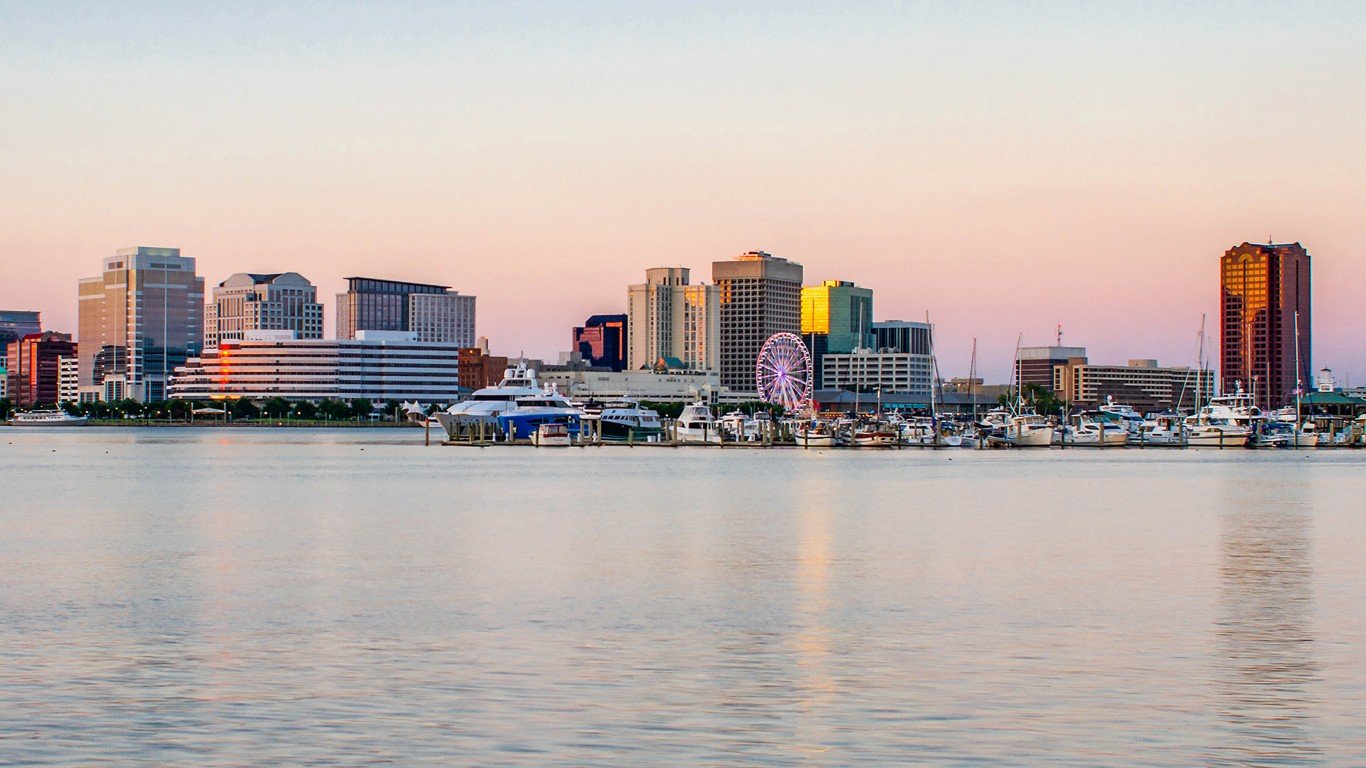
Virginia: Virginia Beach-Norfolk-Newport News
> Avg number of mentally unhealthy days a month: 3.8 (state: 3.8)
> Poverty rate: 10.6% (state: 9.9%)
> Median household income: $69,329 (state: $76,456)
> Adults without health insurance: 7.3% (state: 7.9%)
> People commuting 45+ min: 12.2% (state: 20.5%)
> Dec 2020 unemployment: 5.4% (state: 4.9%)
> Violent crime rate: 350 per 100,000 people (state: 208 per 100,000 people)
> Population: 1,765,031 (state: 8,535,519)
Washington: Longview
> Avg number of mentally unhealthy days a month: 4.7 (state: 4.1)
> Poverty rate: 12.2% (state: 9.8%)
> Median household income: $55,497 (state: $78,687)
> Adults without health insurance: 5.1% (state: 6.6%)
> People commuting 45+ min: 18.0% (state: 20.1%)
> Dec 2020 unemployment: 7.8% (state: 7.1%)
> Violent crime rate: 195 per 100,000 people (state: 294 per 100,000 people)
> Population: 110,593 (state: 7,614,893)

West Virginia: Beckley
> Avg number of mentally unhealthy days a month: 5.7 (state: 5.5)
> Poverty rate: 17.9% (state: 16.0%)
> Median household income: $44,785 (state: $48,850)
> Adults without health insurance: 7.2% (state: 6.7%)
> People commuting 45+ min: 18.2% (state: 16.9%)
> Dec 2020 unemployment: 7.0% (state: 6.3%)
> Violent crime rate: N/A (state: 317 per 100,000 people)
> Population: 115,767 (state: 1,792,147)
[in-text-ad-2]

Wisconsin: Milwaukee-Waukesha-West Allis
> Avg number of mentally unhealthy days a month: 4.0 (state: 4.0)
> Poverty rate: 11.8% (state: 10.4%)
> Median household income: $65,845 (state: $64,168)
> Adults without health insurance: 5.8% (state: 5.7%)
> People commuting 45+ min: 9.3% (state: 10.9%)
> Dec 2020 unemployment: 6.2% (state: 5.5%)
> Violent crime rate: 578 per 100,000 people (state: 293 per 100,000 people)
> Population: 1,575,179 (state: 5,822,434)

Wyoming: Casper
> Avg number of mentally unhealthy days a month: 3.5 (state: 3.8)
> Poverty rate: 8.6% (state: 10.1%)
> Median household income: $65,034 (state: $65,003)
> Adults without health insurance: 12.2% (state: 12.3%)
> People commuting 45+ min: 6.8% (state: 10.5%)
> Dec 2020 unemployment: 6.6% (state: 4.8%)
> Violent crime rate: 286 per 100,000 people (state: 217 per 100,000 people)
> Population: 79,858 (state: 578,759)
Sponsored: Find a Qualified Financial Advisor
Finding a qualified financial advisor doesn’t have to be hard. SmartAsset’s free tool matches you with up to 3 fiduciary financial advisors in your area in 5 minutes. Each advisor has been vetted by SmartAsset and is held to a fiduciary standard to act in your best interests. If you’re ready to be matched with local advisors that can help you achieve your financial goals, get started now.
Thank you for reading! Have some feedback for us?
Contact the 24/7 Wall St. editorial team.
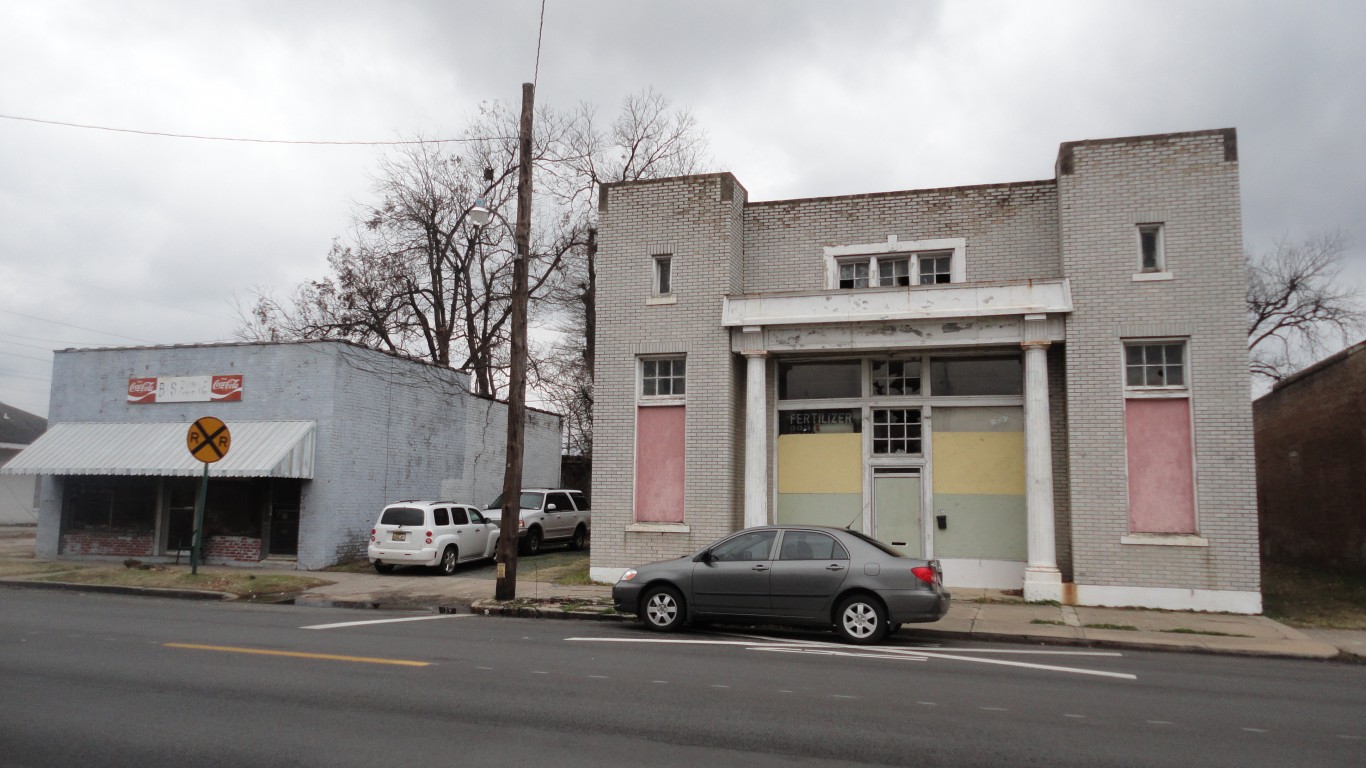
 24/7 Wall St.
24/7 Wall St.
 24/7 Wall St.
24/7 Wall St.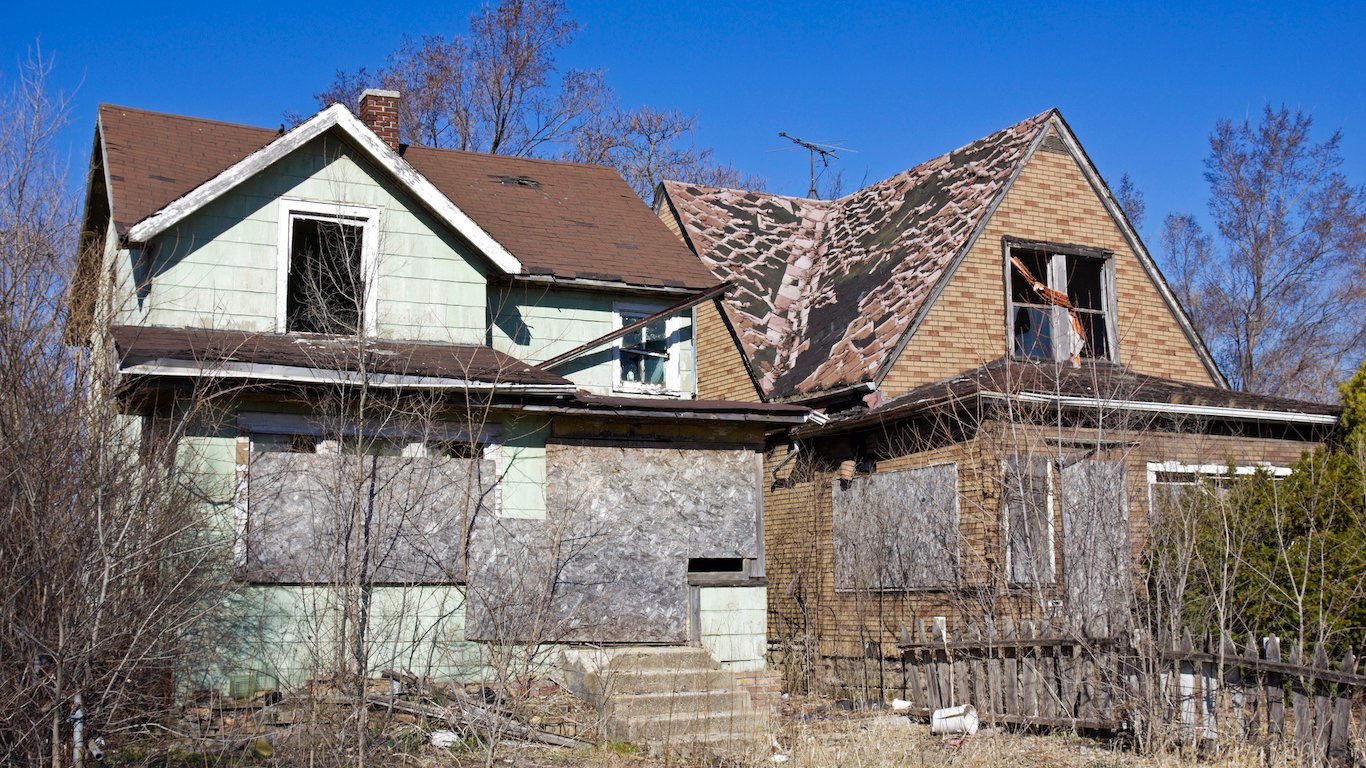 24/7 Wall St.
24/7 Wall St. 24/7 Wall St.
24/7 Wall St.




